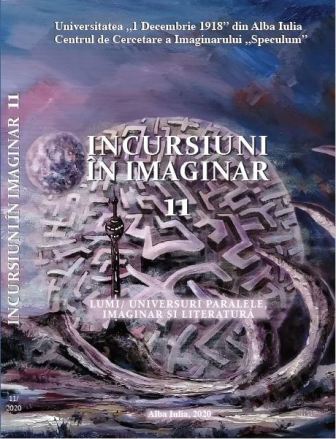The ‘Imaginary’ World of the Afterlife: Parallel World in Bibhutibhushan Bandyopadhyay’s Debjan
The ‘Imaginary’ World of the Afterlife: Parallel World in Bibhutibhushan Bandyopadhyay’s Debjan
Author(s): Ayusman ChakrabortySubject(s): Social history, Recent History (1900 till today), 19th Century, Translation Studies, Theory of Literature, British Literature
Published by: Editura Aeternitas
Keywords: Bibhutibhushan; Debjan; parallel world; hinduism; Saptaloka; theosophy; thought-form; Tulpa;
Summary/Abstract: This article focuses on the presentation of parallel worlds in the early twentieth century Bengali writer Bibhutibhushan Bandyopadhyay’s (1894-1950) novel Debjan (1946) [literally, ‘the path of the Gods’]. Bandyopadhyay is known abroad mainly for his novels Song of the Road (in Bengali Pather Panchali, 1929) and Mountain of the Moon (Bengali Chander Pahar, 1937), both of which have been translated into English. But the majority of his works still remain untranslated, including the novel Debjan. Due to the popularity of the film version of Song of the Road, adapted for the screen by the veteran Bengali filmmaker Satyajit Ray, the author is usually viewed as a realist who meticulously depicted the sad plight of the rural poor in colonial Bengal. But Bibhutibhushan also had a prodigious power of imagination, as manifested in Debjan. The novel depicts the afterlife, where the dead protagonists embark on a cosmic odyssey discovering several parallel worlds along the way. Inspired by religious beliefs, literary works have been depicting parallel worlds of the dead ever since the dawn of civilizations. Following Umberto Eco, one may classify such worlds as “utopias” where the parallel world exists somewhere outside the real world and is normally inaccessible to its inhabitants. From the point of view of researchers in history and cultural studies, such tales interest mainly because they provide us with insight into the religious beliefs and culture of a particular people of a particular age. The distinctiveness of Debjan lies in the fact that its presentation of the afterlife is not entirely based on orthodox Hindu beliefs, even when its author was a Hindu Brahmin by faith. Rather, Bibhutibhushan borrowed much from the tenets of Theosophy to construct his peculiar version of the afterlife in this novel. Though claiming to have its roots in Oriental religions, Theosophy was in reality an Occidental construct which aimed to amalgamate Eastern mysticism with Western occultism. This novel’s mingling of the tenets of Theosophy with those of orthodox Hinduism converts it into a site of encounter between Eastern and Western spiritualism. This paper highlights this aspect of the work, something which has escaped the critics’ attention so far. In the process, it pays particular attention to the concepts of “thought form” and “tulpa” which were popularized in the Anglo-American world by Theosophy and which continue to remain much popular. The basic idea is that the mind or imagination is capable of bringing mental constructs into actual existence through spiritual training and meditation. Bibhutibhushan makes an innovative use of this idea in Debjan. He shows that spirits are capable of producing literally parallel ‘imaginary’ worlds or worlds built with the power of imagination. This is a unique way of imagining parallel worlds in literature, a fact that the article draws attention to. Finally, the article tries to account for the influence of Theosophy on Bibhutibhushan Bandyopadhyay and his generation by taking into consideration both the author’s biography as well as the historical developments in that age.
Journal: Incursiuni în imaginar
- Issue Year: 1/2020
- Issue No: 11
- Page Range: 55-75
- Page Count: 21
- Language: English

